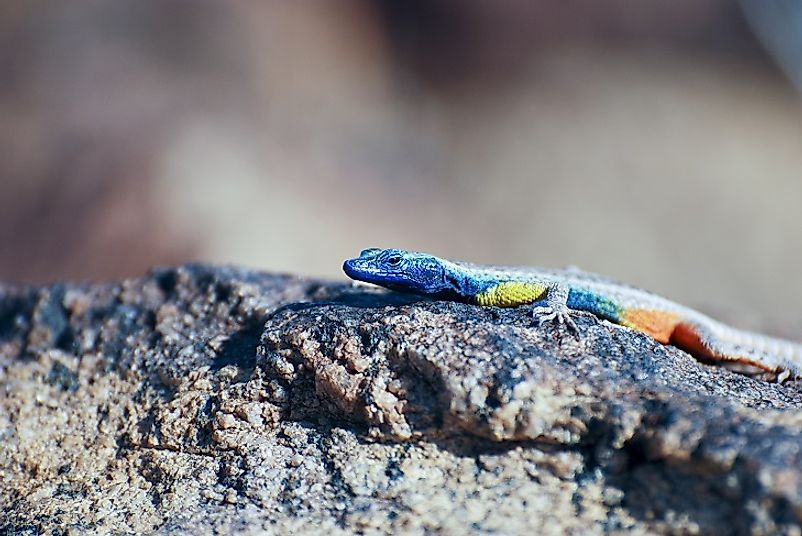Native Reptiles Of South Africa

There are over 350 species of reptiles in South Africa, a country along the southern tip of Africa and flanked by the Indian and Atlantic Oceans. Reptiles are cold-blooded vertebrates of the Class Reptilia, and include lizards, snakes, crocodiles, tortoises, chameleons, and turtles. South Africa, a country that has several unique ecosystems, is home to the richest diversity of reptiles on the African Continent. After Australia and Mexico, South Africa has the richest diversity of reptiles. The country is also rich in endemic reptile species. Transkei Dwarf Chameleons and Geometric Tortoises are some of South Africa's most threatened endemic reptiles.
Zululand Dwarf Chameleon (Bradyopion Nemorale)
The Zululand Dwarf Chameleon is a dwarf chameleon of medium size. Its sub-ocular tubercle is either only slightly raised or not raised at all. It has cranial crests which are developed and distinct. These are not, however, swollen, neither are they horn-colored. Its gular lobes can be described as long rather than broad. There are white gular grooves that pigment in the throat region. Its flanks lack longitudinal grooves. It is ovoviviparous, which means that its eggs are hatched within its body. It has a sharply raised casque. It originates from Qudeni and Nkanala, forests located in Zululand, South Africa. In the International Union for the Conservation of Nature's (IUCN's) Red List of Endangered Species, the Zululand Dwarf Chameleon is classified as threatened because of the limited range, population, and distribution. Being listed in the CITES Appendix II, trade for the species is highly controlled.
Angulate Tortoise (Chersina Angulata)
It is a tortoise species that resides in dry areas and coastal scrub vegetation in South Africa. They are small and shy, have prominent bowsprits, and have only one gular shield under their chins. On their front legs they have five claws, and four on each back leg. Males are larger and thinner than females. They live in fynbos, Albany thickets, Karoo, and coastal scrub vegetation found in the southwest of South Africa, which is a semi-arid area with a Mediterranean climate and more rainfall in the winter. It ranges as far as the South of Namibia. They feed on plants such as hibiscus and mulberry leaves. Its predators include jackals, mongoose, and baboons. They are threatened by wildfires, habitat destruction by human activity, and illegal capture and retention as pets or for sale in the black market.
Yellow-Bellied House Snake (Lamprophis fuscus)
The Yellow-Bellied House Snake is olive green or brown, with a yellow underside and yellow bottom lip. It is a nocturnal animal. Its average length is 50 centimeters, with some reaching 75 centimeters. Their habitat range is seven small patches in Mpumalanga, the Western Cape, and KwaZulu-Natal. They live in arid savanna and grasslands, feeding on lizards and rodents. Their main predators are other snakes. They are oviparous, laying a small number of eggs in the summer. Yellow-Bellied House snakes in captivity can live up to 20 years. They are not venomous and are not prone to bite. The IUCN Red list of endangered species lists them as near-threatened/lower risk.
Augrabies Flat Lizard (Platysaurus broadleyi)
The Augrabies Flat Lizard, also known as Broadley’s Flat Lizard, is endemic to South Africa. It ranges from the Augrabies Falls and Pella to the North Cape in South Africa. Their habitats are rocky savannas. The backs of females and juveniles are dark brown, with three thick cream stripes on the back. Their bellies are white, and at the rear, the color is a range, with a straw-colored tail. The backs of adult males are greenish black, with bluish heads. They have yellow or orange forelimbs, with dark blue throats, black bellies, and orange rears near the tail. The males’ distinct coloration, though intended to attract females also makes it easy for them to be spotted by predators such as kestrels. With their subdued coloration, on the other hand, females are at lower risk of being eaten by predators. Females lay two clutches of eggs in the summer time.
Conservation of South African Reptiles
South Africa is home to the widest range of reptiles in Africa, and some of its other native reptiles include the Transkei Dwarf Chameleon, the Common water snake, the Southpansberg Rock Lizard, the Dwarf Karoo Girdled Lizard, the Robertson Dwarf Chameleon, and the critically endangered Geometric Tortoise. There are also an invasion of reptiles in the country which has become a major problem. Different reptiles have been imported through pet trade, and there are at least 34 species of invasive reptiles in country including ten species of prohibited reptiles
Native Reptiles Of South Africa
| Native Reptiles of South Africa | Binomial Scientific Name |
|---|---|
| Zululand Dwarf Chameleon | Bradypodion nemorale |
| Angulate Tortoise | Chersina angulata |
| Yellow-Bellied House Snake | Lamprophis fuscus |
| Augrabies Flat Lizard | Platysaurus broadleyi |
| Transkei Dwarf Chameleon | Bradypodion caffer |
| Common Brown Water Snake | Lycodonomorphus rufulus |
| Soutpansberg Rock Lizard | Vhembelacerta rupicola |
| Dwarf Karoo Girdled Lizard | Cordylus aridus |
| Robertson Dwarf Chameleon | Bradypodion gutturale |
| Geometric Tortoise | Psammnobates geometricus |







